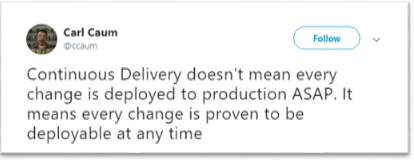The Basics of Continuous Integration & Delivery With 10 Most Popular Tools to Use

Continuous Integration (CI) and Continuous Delivery (CD) are two modern acronyms that seem to have taken the DevOps arena by storm.
We have briefly covered both of them in our ‘What Is DevOps?’ guide, but we figured it was time to take a deep dive into the two pillars of modern development methodology.
Essentially, these are two different processes that work towards the same goal: to assist software developers in streamlining the development and release process.
Similarly, both of them involve frequent code changes that are pushed to the main repository without impacting any of the code changes made by developers working simultaneously. The end goal remains to make the integration process easy by identifying and correcting defects beforehand.
Let’s analyze the details of each process, one by one.
#Continuous Integration
As one of the primary steps when it comes to modern development, Continuous Integration denotes the practice of constantly integrating changes with the main code.
#What Is Continuous Integration?
According to Techopedia, “Continuous integration (CI) is a software development practice in which each member of a development team integrates his work with that produced by others on a continuous basis.”
Basically, CI is a coding philosophy that ensures developers implement the smallest of changes and check the control repositories frequently – which may mean several times a day.
Each and every change that is merged with the main repository is validated by creating a build and then by running automated test cases. While automated test cases are not essentially what continuous integration is, their ability to detect faults means that they have become a common development feature.
As software developers often work alone, CI has emerged as a key practice that is increasingly being adopted by developers around the globe.
Before continuous integration rose to popularity, code integration and merger across different branches was a lengthy ordeal that took days, if not weeks. The results were bugs, merge conflicts and duplicated efforts that made the process inefficient.
Additionally, modern projects require simultaneous coding with different platforms and tools that translate to an integration nightmare if done all at once. Continuous integration provides a thorough mechanism to integrate as well as validate your changes with the main code right at the time you make a change.
#How Does It Work?
Here’s a breakdown of how continuous integration works in easy-to-understand steps:
- Developers normally work in their private terminals; once they are done, they can commit the changes back to the main repository
- As soon as the changes are committed, the continuous integration server analyzes them and assigns a build tag for each one
- The continuous integration server will build the system and run automated integration tests with deployable artifacts for testing
- Whether successful or not, the team receives instant reports of the build status. This may be either that the build was successful or that the code needs fixing
- In case of an error, the team needs to rectify it within the build instantly. This way, continuous integration prioritizes error correction to ensure that everyone is working with the latest codebase.
#Why Use Continuous Integration?
With an emphasis on early error detection and correction, continuous integration offers various advantages over the application’s development lifecycle. Here are some of them:
#Minimized Bug Count
Whenever there is application development, there are bugs – they are an inevitable part of any developer’s life, but CI allows you to minimize the count considerably.
With automated tests constantly being run on any changes made to the main repository, CI helps reduce the overall risk by making detection easier.
#Automation
Before the advent of CI, the integration process was symbolized by lengthy time frames. Continuous integration helps take the manual effort out of the equation so developers can dedicate time for innovation, rather than mundane tasks.
#Increased Transparency
With the entire team getting instant reports about integration failures, it is easier to iron out mistakes that are causing such issues.
Armed with insights into the factors that contribute to failure, the development team can pursue solutions that result in increased efficiency.
#Continuous Delivery
Continuous delivery, as the name suggests, picks up from where continuous integration ends. While CI establishes a consistent integration process, CD automates the delivery of applications so that new iterations can reach the end-consumers more quickly.
This practice allows developers to accelerate their time to market, allowing an opportunity to elicit user feedback more quickly. A hallmark of continuous delivery is that your code is not directly released to production which means that software developers have the chance to conduct manual tests in a staging environment.
For businesses that operate in a highly regulated domain, such as medical technology, this feature is a godsend. Such industries operate under extreme regulations that require fervent testing.
Additionally, having a chance to test your code before releasing it allows you to detect additional bugs and errors that might have been missed by automated build tests conducted at the CI stage.
#Continuous Delivery vs. Continuous Deployment–What’s The Difference?
Another component of modern software development techniques is continuous deployment. Many users continue to confuse the two due to their similar nature. However, the two are not the same – and the difference lies in the implementation.
Continuous delivery dictates that every code change that is validated through automated tests must pass through the developer for manual tests. To drive the point home, here is an excellent tweet that I came across on the subject:
In contrast, continuous deployment bypasses the ‘check with developer’ stage and releases every accepted change right into production. This usually symbolizes a robust software development pipeline that requires a minimal manual.
For organizations that are not restricted by extensive regulatory requirements, continuous deployment should always remain the end goal. Still, there are many cases where it is unfeasible to release every feature – this makes continuous deployment unpractical.
#Why Continuous Delivery?
As the next-step from continuous integration, this can benefit organizations in quite a few ways:
#Increase In Application Quality
With integration testing now automated, continuous delivery allows developers to focus their skill set on exploratory, usability and performance testing. By simultaneously performing these tests in the delivery phase, developers can ensure higher application quality.
#Increased Cost Savings
With an emphasis on early bug detection, continuous delivery ensures that the cost of recurrent fixes and enhancements remains on the lower end.
#Increased Developer Morale
When utilized ideally, continuous delivery makes the process of product release as seamless as possible. Frequent releases ensure that the team is constantly aware of user feedback and ready to implement new ideas based on it.
Not only does this boost the teams’ morale, but it also results in a perfect-fit application.
#Different Tools For Continuous Integration And Continuous Delivery
A well-tested CI/CD pipeline can greatly assist organizations in automating the delivery process for their software – all the way from starting code builds to deploying the code in an environment.
This is why specific cloud native tools have been developed to provide software developers with a safe staging and testing environment. While there are countless options available in the market, we have handpicked 10 of the most popular tools:
#AppVeyor
AppVeyor is one of the leading CI/CD platforms available in the market. As an entirely cloud-based platform, this allows software developers to test and deploy their applications in either the cloud or an on-premise physical server.
With highly secure stand-alone build environments and SSD drive compatibility, AppVeyor is unsurprisingly one of the more common CI/CD platforms in the world.
#AWS CodeBuild
Right from the cloud computing giant’s software hub, the AWS CodeBuild is Amazon’s cloud-hosted CI tool. It allows increased customization where users can mold pre-configured build environments as they want.
This also has extensive support for Node.js, Ruby, Go, Java, Python and Android to name a few. Along with artifact encryption, Amazon’s AWS CodeBuild is a reliable solution for all developers.
#Bamboo
As a widely used framework for software developers around the world, Bamboo deserves a place on this list. Atlassian’s code building tool offers enhanced compatibility with S3, Docker and AWS using any coding language that you prefer.
Additionally, it also offers a custom agent assignment for swift bug fixes and a code history that tracks your progress. While integration with other Atlassian products (Bitbucket, Jira) is a given, Bamboo also offers in-deployment support for added developer feasibility.
#GitLab
How does the idea of an entire fleet of tools dedicated to issue management, code views, continuous integration and deployment in a single dashboard sound?
GitLab provides that and more; a popular CI/CD web application, this tool has an API that stores its state in a database and comes with pre-built packages for Linux distribution. It also provides machine scalability for performance testing and APIs for deeper product integrations.
In short, easy installation, an intuitive interface, high-quality documentation and a vibrant user network make GitLab an important tool for any developer.
#Jenkins
As a comprehensive continuous integration tool, Jenkins offers smooth CI automation across various coding languages. As an open-source option, it can utilize hundreds of plug-ins designed to simplify automated tests, detect bugs, and analyze the code and deployment.
Additionally, Jenkins X gives software developers the ability to automate their CI/CD pipeline in the cloud. Its ability to act as either a CI server or a CD platform is what makes it unique amongst other tools.
Complete with an extensive machine deployment network and pre-built packages for leading computer OS, it offers a well-rounded package to automate your software development process.
Also read: How to install Jenkins on Ubuntu 24.04
#Azure DevOps
Formerly Microsoft Azure’s Visual Studio Team Services, Azure DevOps offers a native continuous integration service as well as planning tools for Scrum and Kanban teams.
It remains an open platform that allows it to be compatible with any development stack and not just with the one provided by Microsoft. It’s also prized for its support on a wide array of control systems and coding languages.
Complete with the ability to build agents on Docker, Azure DevOps remains a popular tool in the software development arena.
#Codeship
If you are looking for a platform that is designed for examining, creating and deploying code directly from a GitHub project – then this CI platform is for you.
Cloudship is highly rated in the software development community due to its simple yet swift process. Additionally, it offers developers a complete set of CI/CD features for precise deployment of any changes to the main code.
With one-step access to GitHub, GitLab and Bitbucket, Codeship further provides Docker Instance support as well as a simplified file management configuration.
#Conclusion
As software development continues to become increasingly important, continuous integration and delivery are considered an important component of the modern software development cycle.
With a focus on early bug detection, seamless delivery process and high-quality applications, it’s safe to say that the coming year will see yet another surge in the number of organizations utilizing CI and CD.
Starting at just $3.24 / month, get virtual servers with top-tier performance.



